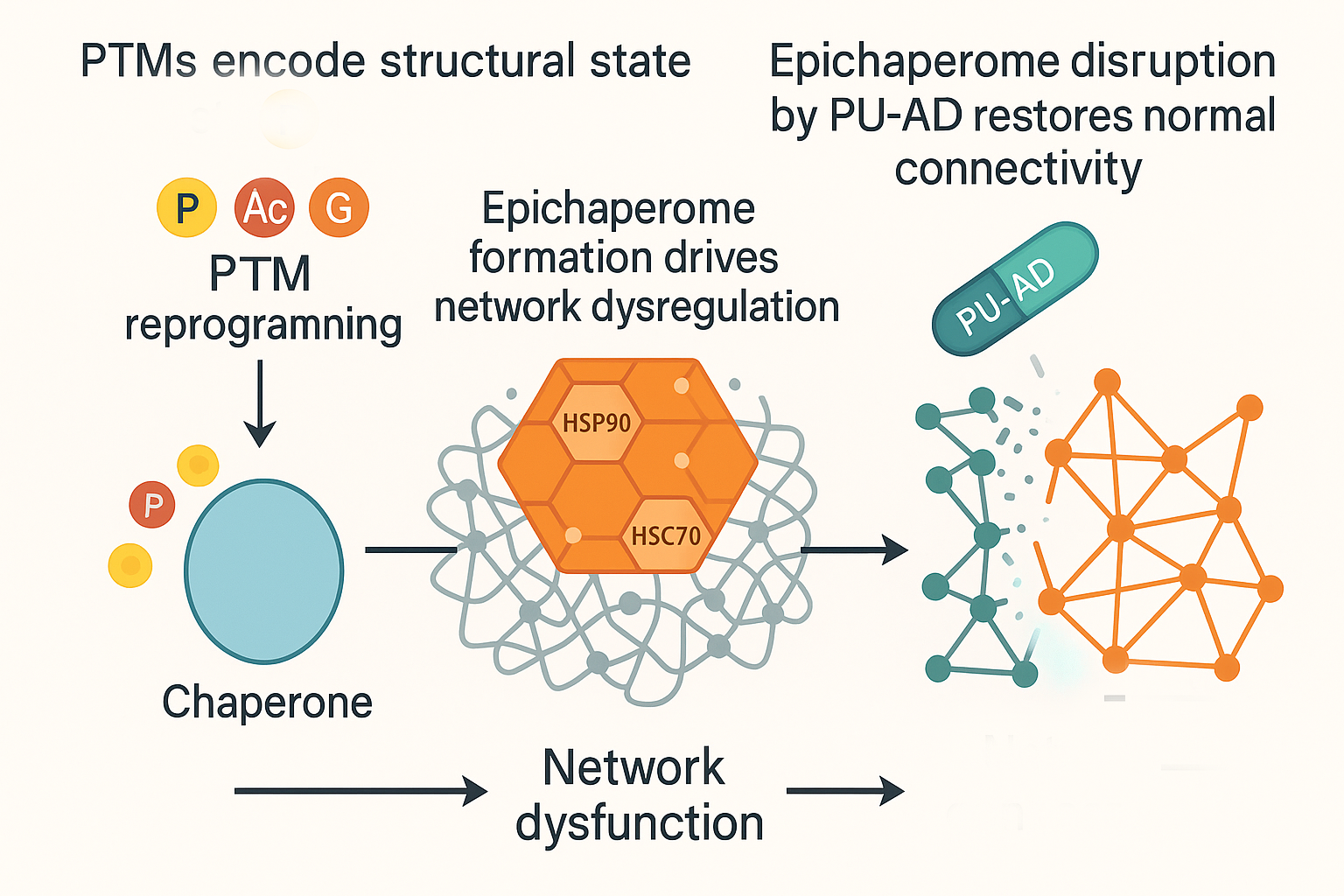How Post-Translational Modifications Rewire Cellular Networks Through Epichaperomes
Published in Chemistry, Neuroscience, and Protocols & Methods
Explore the Research
Redirecting
In our recent review article, we explore how post-translational modifications (PTMs)—the chemical tags that decorate proteins—can fundamentally reprogram these networks by transforming molecular chaperones into stable scaffolds known as epichaperomes.
From fine-tuning to reprogramming
Traditionally, PTMs have been seen as regulatory switches: they turn protein activity up or down, guide localization, or mark proteins for degradation. But evidence now suggests a broader role. PTMs can act as molecular encoders, rewriting how proteins engage with one another. Rather than merely adjusting a single reaction, they can reshape the architecture of the entire protein interaction network.
This idea comes into sharp focus when studying chaperones—the molecular machines best known for assisting protein folding. Under normal conditions, chaperones like HSP90, HSC70, or GRP94 operate dynamically, transiently binding and releasing their clients. However, when specific PTMs accumulate—often within intrinsically disordered regions (IDRs)—these chaperones can transition into new structural states, assembling into multimeric scaffolds called epichaperomes.
Epichaperomes: when chaperones become scaffolds
Epichaperomes are not simply larger chaperone complexes. They are organized, stable, and persistent—platforms that integrate numerous chaperones, co-chaperones, and client proteins into a cohesive, supramolecular structure.
Once formed, these scaffolds remodel the cell’s interactome, clustering specific sets of proteins and locking them into functional modules. In doing so, they effectively rewire how cellular pathways communicate. Some pathways are reinforced, others silenced. The overall effect is a new network topology—one that can sustain disease states such as cancer or neurodegeneration.
Encoding dysfunction through PTMs
What drives this transformation? PTMs are both the trigger and the code. For example, phosphorylation within the IDRs of HSP90 can stabilize conformations that promote epichaperome assembly, while glycosylation of GRP94 at key residues facilitates its incorporation into membrane-associated epichaperomes that amplify signaling.
These site-specific modifications don’t just modify single residues—they define new structural identities for the proteins, creating an encoded form of network memory that persists long after the original stress signal has passed.
From molecular code to therapeutic target
Understanding PTMs as encoders opens a different way to think about disease. It shifts attention from expression-level changes to network-level architecture. Drugs that target these architectures—such as epichaperome disruptors (for example, PU-H71 and PU-AD)—don’t simply inhibit protein activity. Instead, they disassemble the pathological scaffolds that maintain dysregulated networks, restoring the cell’s natural connectivity.

Figure Legend: Post-translational modifications (PTMs) reprogram chaperones into stable supramolecular assemblies known as epichaperomes. These scaffolds drive network dysregulation by reorganizing protein–protein interactions. Pharmacologic disruption of epichaperomes with PU-AD restores normal network connectivity.
This approach has implications far beyond one disease class. In cancers, epichaperomes reinforce proliferative signaling. In the brain, they destabilize synaptic communication and energy metabolism. Across contexts, their emergence reflects a universal mechanism: PTM-driven network reprogramming.
A new perspective on protein regulation
We are only beginning to decode how PTM “signatures” direct the formation of supramolecular assemblies like epichaperomes. Yet this concept may reshape how we view the proteome itself—from a catalog of individual molecules to a dynamic, PTM-encoded system of networks.
By understanding how chemical modifications can rewire the cell’s architecture, we move closer to targeting disease not at the level of a single gene or protein, but at the level of how the network itself is built.
Further Reading
Chu F, Sharma S, Ginsberg S.D., Chiosis G. PTMs as molecular encoders: reprogramming chaperones into epichaperomes for network control in disease. Trends Biochem Sci. 2025 Oct;50(10):892–905. https://doi.org/10.1016/j.tibs.2025.07.006.
Bay S., Rodina A., Haut F., Roychowdhury T., Argyrousi E.K., Staniszewski A., et al. Systems-Level Interactome Mapping Reveals Actionable Protein Network Dysregulation Across the Alzheimer's Disease Spectrum. Res Sq [Preprint]. 2025 Feb 12:rs.3.rs-5930673. https://doi.org/10.21203/rs.3.rs-5930673/v1.
Roychowdhury T., McNutt S.W., Pasala C., Nguyen H.T., Thornton D.T., Sharma S., et al. Phosphorylation-driven epichaperome assembly is a regulator of cellular adaptability and proliferation. Nat Commun. 2024 Oct 16;15(1):8912. https://doi.org/10.1038/s41467-024-53178-5
Yan P., Patel H.J., Sharma S., Corben A., Wang T., Panchal P., et al. Molecular stressors engender protein connectivity dysfunction through aberrant N-glycosylation of a chaperone. Cell Rep. 2020 Jun 30;31(13):107840. https://doi.org/10.1016/j.celrep.2020.107840
Inda M.C., Joshi S., Wang T., Bolaender A., Gandu S., Koren J III, et al. The epichaperome is a mediator of toxic hippocampal stress and leads to protein connectivity–based dysfunction. Nat Commun. 2020 Jan 16;11(1):319. https://www.nature.com/articles/s41467-019-14082-5

Please sign in or register for FREE
If you are a registered user on Research Communities by Springer Nature, please sign in